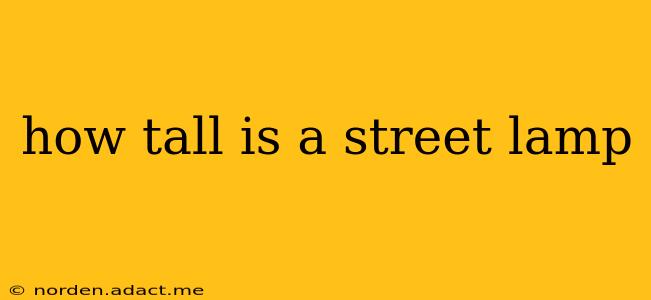Street lamps, those ubiquitous fixtures illuminating our nights, come in a surprising variety of heights. There's no single answer to "How tall is a street lamp?" because the height depends on several factors. This guide will delve into the specifics, answering common questions and providing a comprehensive understanding of street lighting design.
What Determines the Height of a Street Lamp?
Several factors influence the height of a street lamp, creating a range rather than a fixed measurement. These include:
-
Location: Street lamps in residential areas are often shorter than those on busy highways or in industrial zones. Residential areas may prioritize aesthetics and minimize light pollution, opting for shorter poles. Highways require greater illumination across wider areas, necessitating taller poles for broader coverage.
-
Type of Lamp: Different types of lamps have varying light output and beam patterns. High-pressure sodium (HPS) lamps, for example, often require taller poles for optimal dispersion than LED lamps, which can achieve similar illumination with shorter poles due to their more focused beam.
-
Surrounding Environment: Obstructions like trees, buildings, and overhead wires can influence pole height. Taller poles might be necessary to clear obstructions and ensure adequate illumination.
-
Safety and Maintenance: Taller poles might present safety challenges during maintenance and repairs, requiring specialized equipment and training. Therefore, height is often a compromise between effective illumination and practical maintenance considerations.
-
Aesthetics: In some areas, particularly historic districts or areas with specific architectural styles, the height of street lamps is carefully considered to maintain visual harmony and preserve the character of the location.
How Tall Are Street Lamps Typically?
While there's no standard height, street lamps typically range from 8 to 30 feet (2.4 to 9.1 meters). However, some specialized applications might use poles outside this range.
-
Residential Areas: These typically use shorter poles, often between 8 and 15 feet (2.4 and 4.6 meters).
-
Commercial Areas and Highways: These often require taller poles, ranging from 15 to 30 feet (4.6 to 9.1 meters) or even higher.
What Are the Different Types of Street Lights?
Street lamps aren't just about height; the type of lighting also matters significantly:
-
High-Pressure Sodium (HPS): These were once very common, offering good light output but less energy efficiency than newer options.
-
Metal Halide (MH): Offering better color rendering than HPS, these are becoming less prevalent due to the rise of LEDs.
-
Light Emitting Diodes (LEDs): Currently the most popular choice due to their high energy efficiency, long lifespan, and improved color rendering capabilities. LED street lights often allow for more flexible placement and potentially shorter poles.
What are the benefits of using different heights of street lights?
Varying street light heights offers several benefits:
-
Optimized Illumination: Tailoring height to the specific location ensures efficient light distribution, minimizing light pollution and maximizing visibility where it's needed most.
-
Improved Safety: Properly placed and sized lighting contributes to enhanced safety for pedestrians and drivers.
-
Cost Savings: Employing energy-efficient lighting combined with strategically chosen heights can significantly reduce energy consumption and maintenance costs.
-
Aesthetic Appeal: Careful consideration of pole height and design contributes to the overall aesthetic appeal of the environment.
Are there any regulations on street lamp height?
Regulations on street lamp height vary significantly by location and are typically determined by local building codes, zoning ordinances, and utility company standards. These regulations often consider factors like safety, visibility, and aesthetics, sometimes specifying minimum or maximum allowable heights for different zones or applications. Always check with your local authorities for specific regulations in your area.
This comprehensive overview addresses the variability in street lamp heights, the factors influencing that variability, and the implications for lighting design and urban planning. Remember, the next time you see a street lamp, consider the many factors that went into determining its height and the role it plays in illuminating our world.
